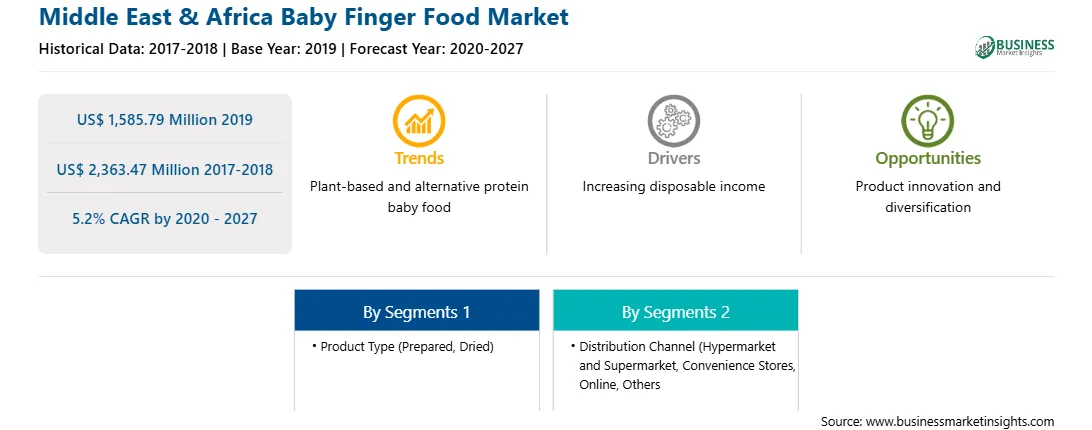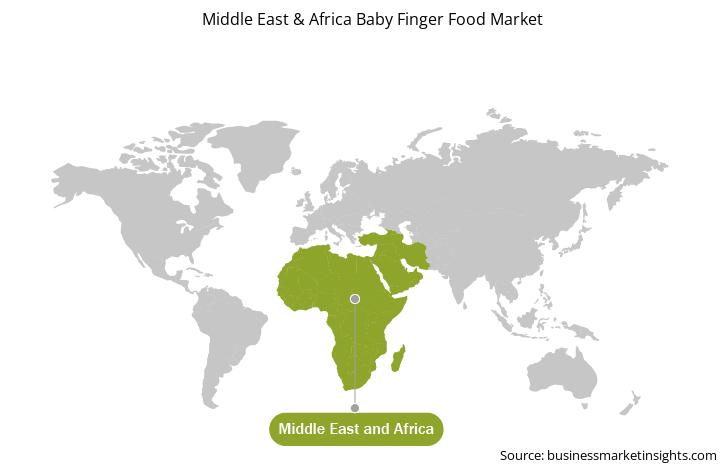Finger foods are defined as small food pieces, which could behold, and eaten by infants and babies of age group 6-12 months. Such kind of food products are known for their nutritional values and convenience in consumption. These include fruit flavoured sweet finger food along with the savoury forms such as puffs, breadsticks, biscuits, wafers and others and fruits and vegetable based finger foods. Baby finger food is available in various flavors and both solid and liquid forms. Latest technological innovation has allowed manufactures to push the limits of baby food, into finger foods. The change in working demographics along with adoption of modern lifestyles and an increase in disposable income have resulted in an increase in demand for baby finger food.
Strategic insights for the Middle East & Africa Baby Finger Food provides data-driven analysis of the industry landscape, including current trends, key players, and regional nuances. These insights offer actionable recommendations, enabling readers to differentiate themselves from competitors by identifying untapped segments or developing unique value propositions. Leveraging data analytics, these insights help industry players anticipate the market shifts, whether investors, manufacturers, or other stakeholders. A future-oriented perspective is essential, helping stakeholders anticipate market shifts and position themselves for long-term success in this dynamic region. Ultimately, effective strategic insights empower readers to make informed decisions that drive profitability and achieve their business objectives within the market.

| Report Attribute | Details |
|---|---|
| Market size in 2019 | US$ 1,585.79 Million |
| Market Size by 2027 | US$ 2,363.47 Million |
| CAGR (2020 - 2027) | 5.2% |
| Historical Data | 2017-2018 |
| Forecast period | 2020-2027 |
| Segments Covered |
By Product Type
|
| Regions and Countries Covered | Middle East and Africa
|
| Market leaders and key company profiles |
|
The geographic scope of the Middle East & Africa Baby Finger Food refers to the specific areas in which a business operates and competes. Understanding local distinctions, such as diverse consumer preferences (e.g., demand for specific plug types or battery backup durations), varying economic conditions, and regulatory environments, is crucial for tailoring strategies to specific markets. Businesses can expand their reach by identifying underserved areas or adapting their offerings to meet local demands. A clear market focus allows for more effective resource allocation, targeted marketing campaigns, and better positioning against local competitors, ultimately driving growth in those targeted areas.

The baby finger food market in MEA is expected to reach US$ 2,363.47 million by 2027 from US$ 1,585.79 million in 2019; it is expected to grow at a CAGR of 5.2% from 2020 to 2027. The growth of the baby care industry has led to an increased demand for various products, such as baby finger food. It is an emerging market for baby finger food products owing to the increasing availability of international baby finger food brand products in the developed countries along with the rising expenditure of parents on baby food products. With the modification in the baby food habits of the people in the Middle East, the consumption of baby finger food products would increase rapidly in the coming years. Availability of an array of baby finger food is the key factor driving the MEA baby finger food market. The demand and popularity of the baby finger foods are growing at a staggering rate. These foods offer a tasty and sort of finger food for babies. Lotus Bakeries Corporate Kiddylicious introduced innovative NPD – Kiddylicious Melty Buttons and Kiddylicious Juicy Fruit Bars. Kiddylicious Melty Buttons are tasty rice buttons made with fruit and vegetables, excellent finger food for little hands. They are available in raspberry & beetroot and banana & pumpkin. As these foods are available in various flavors, babies become more excited to have such finger food. Danalac baby teething biscuits are best for growing babies as they start teething and gradually require more solid foods than just baby milk. These baby cookies are also a great snack and healthy finger food for children. The baby teething biscuits and baby finger foods are made with wholesome ingredients that help kid’s growth. The products are available in various flavors such as natural, cocoa, and banana. Baby finger food products are estimated to have a growing opportunity in the MEA region due to its increasing shift of parents towards packed and convenience baby food and snack products. The baby finger food market in the Middle East region is also fueled by rise in financial status and spending power of the consumers and fast growth in the online retail sector. The increase in the birth rates across the developed and developing countries and growing awareness about child's nutrition are also prominent factors boosting the growth of the market over the forecast period. However, the presence of high level of sugar content along with high price associated with baby finger food is hampering the growth of the baby finger food market in MEA.
COVID-19 pandemic has affected industries and economies in various countries due to lockdowns, business shutdowns, and travel bans which will adversely affect the baby finger food market. Saudi Africa has the largest COVID-19 cases in the MEA region, and is followed by Saudi Arabia and UAE, among others. UAE was the first country in MEA to report a confirmed case of COVID-19.
The market for baby finger food is segmented into product type and distribution channel. On the basis of product type, the baby finger food market is categorized into prepared, dried, and others. In 2019, the prepared segment dominated the market of the total market share and is projected to continue its dominance over the forecast period. Based on distribution channel, the baby finger food market is categorized into hypermarket and supermarket, convenience stores, online and others. In 2019, the online segment is expected to be the fastest growing segment over the forecast period.
A few major primary and secondary sources referred to for preparing this report on the baby finger food market in MEA are company websites, annual reports, financial reports, national government documents, and statistical database, among others. Major companies listed in the report are Nestlé, S.A.; Kraft-Heinz, Inc.; The Hain Celestial Group, Inc.; HiPP GmbH & Co. Vertrieb KG; Lotus Bakeries Corporate, and Dana Dairy Group among others.
The Middle East & Africa Baby Finger Food Market is valued at US$ 1,585.79 Million in 2019, it is projected to reach US$ 2,363.47 Million by 2027.
As per our report Middle East & Africa Baby Finger Food Market, the market size is valued at US$ 1,585.79 Million in 2019, projecting it to reach US$ 2,363.47 Million by 2027. This translates to a CAGR of approximately 5.2% during the forecast period.
The Middle East & Africa Baby Finger Food Market report typically cover these key segments-
The historic period, base year, and forecast period can vary slightly depending on the specific market research report. However, for the Middle East & Africa Baby Finger Food Market report:
The Middle East & Africa Baby Finger Food Market is populated by several key players, each contributing to its growth and innovation. Some of the major players include:
The Middle East & Africa Baby Finger Food Market report is valuable for diverse stakeholders, including:
Essentially, anyone involved in or considering involvement in the Middle East & Africa Baby Finger Food Market value chain can benefit from the information contained in a comprehensive market report.